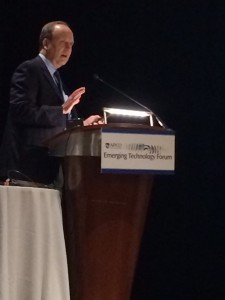WiFi Access Points Lead Location Accuracy Technology Talks
By Stephen Martini
Find the door we need to kick down.
That was the message underscored multiple times Tuesday, March 15, during the first day of Association of Public-Safety Communications Officials (APCO) International’s Emerging Technology Forum in Kansas City, Mo., as subject matter experts discussed upcoming efforts to improve 9-1-1 location accuracy.

On Tuesday, March 15, during the first day of Association of Public-Safety Communications Officials (APCO) International’s Emerging Technology Forum in Kansas City, Mo., subject matter experts discussed upcoming efforts to improve 9-1-1 location accuracy.
“I don’t want to find just the right building,” said Jay English, director of Communications Center and 9-1-1 Services at APCO, “but the right room on the right floor of the right building.”
Kent Hellebust, vice-president of safety and security technologies at Comtech Telecommunications Corp (formerly TCS) addressed the state of wireless location technologies today.
Existing wireless phase 2 technology provides an estimated location for cellular callers with a delayed ALI delivered to the PSAP after the initial call. While this was the initial goal—to deliver low-accuracy location quickly and follow-up with high-accuracy later—Hellebust said it is a problem.

Kent Hellebust, vice-president of safety and security technologies at Comtech Telecommunications Corp (formerly TCS).
“I think everyone in this room knows there’s a problem with indoor 9-1-1 wireless calls,” he said, “but what is the scope of the problem?”
He underscored his point by referencing results from testing completed in King County, Wash. (Seattle), Tarrant County, Tex. (Fort Worth), and Baltimore, Md., from 2007 through 2014. Results showed wireless 9-1-1 calls in dense urban areas of Tarrant County were delivered with poor location accuracy (more than 150 meters) compared to those placed in rural areas. Results also showed that of most 9-1-1 calls placed in King County, Wash., delivered initially with wireless phase 1 location data (cell site address only), 75 percent took an average of 24 seconds to return wireless phase 2 location data when the telecommunicator manually initiated a rebid.
Most studies agree that 70 percent to 80 percent of all 9-1-1 calls delivered to a PSAP originate from cell phones.
In a world where seconds save lives, spending dozens of seconds waiting to obtain even an estimated location of the incident is unacceptable or, as Hellebust stated, “sub-optimal.”
While accurate GPS coordinates returned upon first rebid 87 percent of the time, some calls required additional rebids while others didn’t return wireless phase 2 data at all.
What Can Be Done to Improve Wireless Location Today?
Hellebust and Jeff Cohen, chief counsel for APCO, explored some options being considered to improve wireless caller location.
Most immediately, Hellebust acknowledged the growing installation and use of microcell technology, such as femtocells and picocells. These devices, installed in homes or businesses, function within a tight geographic radius and can display a registered location, similar to VoIP phones. Installing small cells inside businesses and homes along jurisdictional boundaries helps reduce the number of misrouted calls to neighboring PSAPs.
What Can Be Done to Improve Wireless Location Tomorrow?
Less immediately, Hellebust stated satellite technology has, according to some studies, doubled cell location accuracy as the number of satellites looking at the device increases. However, he noted that adding satellites requires a long lead time, not only to create and launch a satellite, but also to update the required chipsets within individual handsets to recognize the additional eyes in the sky.
Also on the horizon are the FCC’s Wireless E911 Location Accuracy Requirements, created in tandem with APCO and NENA, and ordered in January 2015, which explore the need to identify a dispatchable location on all wireless 9-1-1 calls.

The FCC is working with the four largest wireless carriers—AT&T, Verizon, Sprint and T-Mobile—to conduct tests in metro areas around the nation attempting to determine wireless caller location using z-coordinate and WiFi access points.
Commercial partners are already using WiFi access points to push data to consumers through apps, such as RetailMeNot—a shopping app that pushes sales notices or coupons to consumers when they travel near a store featuring a promotion.
Cohen referenced a living history project inside historic Union Station—just feet from the Kansas City Westin Hotel—that uses similar technology to share historically relevant information with visitors via their cell phone as they walk through the building.
“These devices can be put inside lamps, or exit signs, or plugged into outlets on the wall,” Cohen said, potentially providing a very precise location within location for an incident to the PSAP.
The location of each device would be loaded into a master database—the National Emergency Address Database (NEAD)—which conceptually could deliver a reliable, dispatchable location to the PSAP within two to four seconds of initial call delivery. This is well under the 24-second average currently experienced with wireless phase 2 technology.
“There’s a lot of promise in this technology, but there are still a lot of unknowns,” Cohen said.
To learn more, visit APCO’s Government Relations Office webpage at www.apcointl.org/advocacy.

